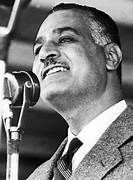Thursday's Columns
February 22, 2024
THE CANALS
Two Paths
(Part 2)
by
Lawrence Abby Gauthier
ace reporter
The Westphalia Periodic News

GAMAL ABDUL NASSER

A HIGHWAY AND RAIL LINE
ALONG THE NEGEV ROUTE
Long before there was a man named David Ben-Gurion or a State of Israel -- when Palestine was just Palestine -- the route now proposed for the Ben-Gurion Canal was known as the Negev route.
The Negev route was considered a potential alternative when the Suez Canal was first being dreamed up in the mid-19th century. Either route would have served the same purpose -- the movement of goods between Europe and Asia. In the end, however, geology and the machinery of the day played a decisive role -- it was easier to dig through Egyptian sand than the rocky landscape of the Negev Desert.
Initially, the Suez project was jointly financed and owned by French investors and the Egyptian king. However, when the king ran short of cash during the worldwide economic depressions of the late 19th century, he sold his shares to British investors who became the largest block of stockholders in the Suez Canal Company, which owned and operated the canal and distributed the profits. To protect their investment, in 1875 England invaded and conquered Egypt.
To create a veneer of legitimacy, as they did throughout their Empire, the colonizers let Egypt keep its kings, descendants of Mohammed Ali. British “advisors” would tell the kings what to do.
Egypt’s last king was King Farouk, a big fat man who spent most of his time living it up around the gambling dens of Monte Carlo and cheating on his wives.
In 1952, Farouk was deposed in a coup by army officers. Two years later, in 1954, one of the leaders of the coup, somebody typically described as “a young, fiery nationalist,” became Egypt’s president. His name was Gamal Abdul Nasser.
Nasser wanted to “develop” his country to make life better for the people. He’d come from humble beginnings and knew the stories of the Egyptian people under foreign rule.
He wanted to start by building a dam on the Nile to irrigate new lands and supply the water and energy the country would need for all the new industry he envisioned, like their own factories to process their own cotton rather than sending it off to England to be processed there -- the same situation colonial America had faced before its violent Revolution.
It would be a big project, the largest earthen dam in the world… the Aswan High Dam. Nasser went looking for investors, starting with the Americans.
At the time, during the Eisenhower Administration in the 50s, American foreign policy was dominated by the Dulles Brothers -- Allan as Director of the CIA and John Foster Dulles as Secretary of State. Both were fanatical anti-Communists. Their worldview was Manicheistic -- “thems” and “us’s” with nothing in between, the shining light of America or the darkness of godless Russia.
I’ve recently been reading a book that covers the reception Nasser got from the Dulles brothers. Published in 2013 and written by New York Times journalist and historian Stephen Kinzer, it’s called, “THE BROTHERS: John Foster Dulles, Allan Dulles, and Their Secret World War.”
Kinzer writes that when Nasser first met John Foster Dulles in 1953, the powerful American Secretary of State “warned him about the Soviet threat.”
According to Kinzer, Nasser tartly replied that the Soviets “have never occupied our country, but the British have been here for seventy years.”
The Brothers were suspicious but still hoped they could “work” with the new Egyptian strongman. If he didn’t want to be on the team for philosophical reasons, ok, but maybe he could be bribed.
The CIA’s top agent in the region was Kermit Roosevelt, who had just orchestrated the successful operation against Mosaddegh in Iran. Allan had him dispatched to Egypt with $3 million to spread around. Nasser was offered a “security partnership” and $20 million in military aid. Kinzer writes that Foster told Nasser that if he became a “U.S. ally” that America might finance his “dream project” – the Aswan High Dam.”
The proud Egyptian who would come to lead the global nonaligned movement of the 50s and 60s could not be bribed into taking sides. He really wanted the Americans to help Egypt build the dam, but would not accept the strings they attached.
Kinzer writes that the Brothers were angry and frustrated. They called Nasser all kinds of names. Foster made his final take-it-or-leave-it offer during a meeting with Egyptian Ambassador Hussein on July 19, 1956. The ambassador told Foster that the Russians had also been offering to help finance the dam. According to Kinzer, Foster curtly replied: “Well then, as you already have the money, you have no need of our help. The offer is withdrawn.”
Informed of the decision, Nasser, Kinzer writes, was “outraged” and said, “Americans, may you choke on your fury.”
Six days later, on July 26, 1956, just as a revolt in Hungary was being crushed by Russian tanks, Nasser nationalized the Suez Canal.
Without American support, Egypt needed the “owner’s share” of canal profits to complete the financing for the dam. Nasser probably also had personal reasons.
Egypt was immediately attacked by the armies of France and England and Israel. The Brothers supposedly watched from the sidelines but would not have minded seeing Nasser punished. In their eyes, the greatest sin – greater than being a card-carrying communist – was to be “nonaligned.”
But Eisenhauer didn’t like what he was seeing. Things were getting out of hand. Seeing tanks and warplanes and soldiers laid out dying on blood-soaked stretchers brought back memories. Also, he was facing reelection and didn’t need a war in the Mideast to distract voters from his achievements like the Interstate System that would bear his name spreading across the country like an organic vine; or Atoms for Peace. He had the power to end the fighting. And that’s what he decided to do. He threatened to instruct his Treasury Department to dump the Europeans’ bonds, collapsing the value of their currencies, if they didn’t stop it.
They stopped it, the dam was built and Nasser went on to become a giant figure in any history of the 20th Century.
Before Foster died and Allan got fired by Kennedy, the Brothers never gave up trying to get rid of Nasser the way they’d gotten rid of Arbenz in Guatemala or Mosaddegh in Iran… Lumumba, Sukarno – the nonaligned. Through connections within the Muslim Brotherhood, assassination plots were hatched, but Nasser’s security was impenetrable, he was too much of a force.
The fact that a nonaligned nation now controlled the vital passageway between East and West sent red flags up all over Washington.
America would have to respond.
But how?
I don’t know who it was -- maybe a faceless bureaucrat -- but somebody had an idea…
“We could build our own canal along the old Negev route.”
(to be continued…)
